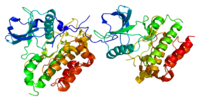
Photo from wikipedia
Osteoid osteoma and osteoblastoma are bone-forming tumors shown to harbor FOS (87%) and FOSB (3%) rearrangements. The aim was to evaluate the immunohistochemical expression of FOS and FOSB in these… Click to show full abstract
Osteoid osteoma and osteoblastoma are bone-forming tumors shown to harbor FOS (87%) and FOSB (3%) rearrangements. The aim was to evaluate the immunohistochemical expression of FOS and FOSB in these tumors in comparison to other bone tumors, to evaluate the influence of decalcification, and to correlate immunohistochemical findings with the underlying genetic alteration using fluorescence in situ hybridization (FISH). Immunohistochemistry using whole sections was performed on osteoid osteoma ( n =23), osteoblastoma ( n =22), osteoblastoma-like osteosarcoma ( n =3), reactive ( n =3), and proliferative ( n =11) bone lesions. Immunoreactivity in giant cell tumor of bone ( n =74), aneurysmal bone cyst ( n =6), chondromyxoid fibroma ( n =20), osteosarcoma ( n =85), chondroblastoma ( n =17), and clear cell chondrosarcoma ( n =20) was assessed using tissue micro arrays. Strong nuclear expression of FOS in > 50% of the tumor cells was observed in all osteoid osteomas (22/22), in 57% of osteoblastomas (12/21) and in 3/197 control cases. FOS immunoreactivity disappeared after > 3 days decalcification. FOS rearrangements were present in 94% of osteoid osteomas and osteoblastomas, with a concordance of 86% between FISH and immunohistochemistry. Two osteoblastomas (5%) were positive for FOSB, as opposed to 8/177 control cases. Additional FISH revealed no FOSB rearrangements in these cases. To conclude, in short decalcified biopsies, FOS immunohistochemistry can be used to diagnose osteoid osteoma and osteoblastoma, as overexpression is seen in the majority, being rare in their mimics. FOS immunohistochemistry should not be used after long decalcification. Moreover, low level of focal expression found in other lesions and tissues might cause diagnostic problems, in which case FISH could be employed.
Journal Title: Virchows Archiv
Year Published: 2019
Link to full text (if available)
Share on Social Media: Sign Up to like & get
recommendations!